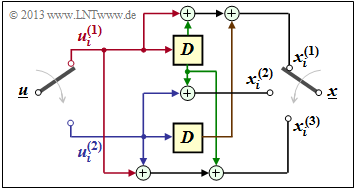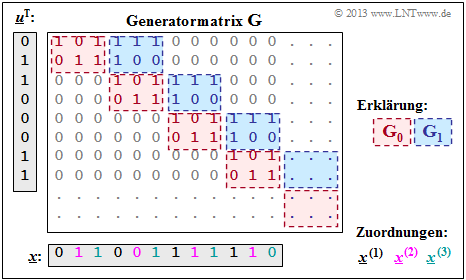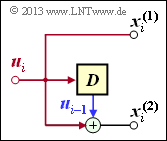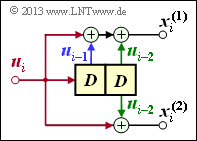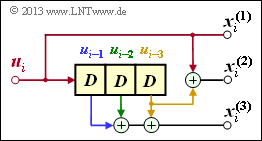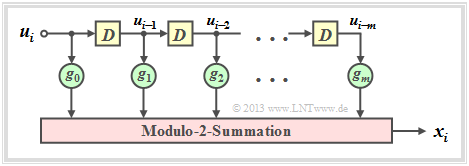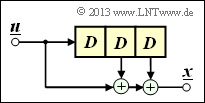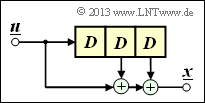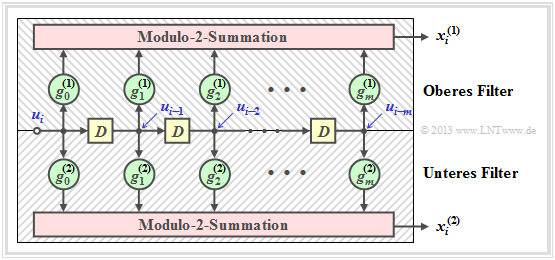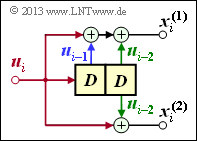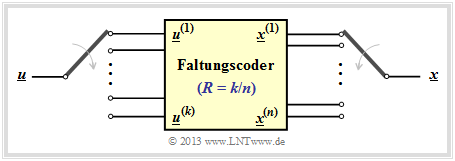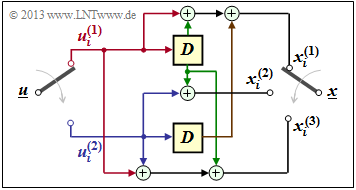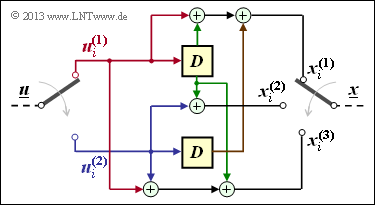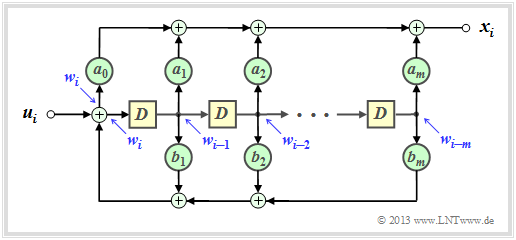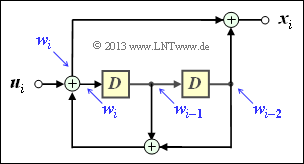Difference between revisions of "Channel Coding/Algebraic and Polynomial Description"
m (Text replacement - "„" to """) |
|||
| Line 1: | Line 1: | ||
{{Header | {{Header | ||
| − | |Untermenü= | + | |Untermenü=Convolutional Codes and Their Decoding |
| − | |Vorherige Seite= | + | |Vorherige Seite=Basics of Convolutional Coding |
| − | |Nächste Seite= | + | |Nächste Seite=Code Description with State and Trellis Diagram |
}} | }} | ||
| − | == | + | == Division of the generator matrix into partial matrices == |
<br> | <br> | ||
| − | + | Following the discussion in the earlier section [[Channel_Coding/General_Description_of_Linear_Block_Codes#Linear_codes_and_cyclic_codes| "Linear Codes and Cyclic Codes"]] the codeword $\underline{x}$ of a linear block code can be determined from the information word $\underline{u}$ and the generator matrix $\mathbf{G}$ in a simple way: $\underline{x} = \underline{u} \cdot { \boldsymbol{\rm G}}$. The following holds: | |
| − | * | + | *The vectors $\underline{u}$ and $\underline{x}$ have length $k$ (bit count of an information word), respectively. $n$ (bit count of a codeword) and $\mathbf{G}$ has dimension $k × n$ $(k$ rows and $n$ columns$)$.<br> |
| − | * | + | *In convolutional coding, on the other hand $\underline{u}$ and $\underline{x}$ denote sequences with $k\hspace{0.05cm}' → ∞$ and $n\hspace{0.05cm}' → ∞$. Therefore, the generator matrix $\mathbf{G}$ will also be infinitely extended in both directions.<br><br> |
| − | + | In preparation for the introduction of the generator matrix $\mathbf{G}$ on the next page, we define $m + 1$ partial matrices, each with $k$ rows and $n$ columns, which we denote by $\mathbf{G}_l$ where $0 ≤ l ≤ m$ holds.<br> | |
{{BlaueBox|TEXT= | {{BlaueBox|TEXT= | ||
| − | $\text{Definition:}$ | + | $\text{Definition:}$ The '''partial matrix''' $\mathbf{G}_l$ describes the following fact: If the matrix element $\mathbf{G}_l(\kappa, j) = 1$, this says that the code bit $x_i^{(j)}$ is influenced by the information bit $u_{i-l}^{(\kappa)}$ . Otherwise, this matrix element is equal to $0$.}}<br> |
| − | + | This definition will now be illustrated by an example. | |
| − | [[File:P ID2600 KC T 3 1 S4 v1.png|right|frame| | + | [[File:P ID2600 KC T 3 1 S4 v1.png|right|frame|Convolutional encoder with $k = 2, \ n = 3, \ m = 1$]] |
{{GraueBox|TEXT= | {{GraueBox|TEXT= | ||
| − | $\text{ | + | $\text{Example 1:}$ |
| − | + | We again consider the convolutional encoder according to the diagram with the following code bits: | |
::<math>x_i^{(1)} = u_{i}^{(1)} + u_{i-1}^{(1)}+ u_{i-1}^{(2)} \hspace{0.05cm},</math> | ::<math>x_i^{(1)} = u_{i}^{(1)} + u_{i-1}^{(1)}+ u_{i-1}^{(2)} \hspace{0.05cm},</math> | ||
| Line 29: | Line 29: | ||
::<math>x_i^{(3)} = u_{i}^{(1)} + u_{i}^{(2)}+ u_{i-1}^{(1)} \hspace{0.05cm}.</math> | ::<math>x_i^{(3)} = u_{i}^{(1)} + u_{i}^{(2)}+ u_{i-1}^{(1)} \hspace{0.05cm}.</math> | ||
| − | + | Because of the memory order $m = 1$ this encoder is fully characterized by the two partial matrices $\mathbf{G}_0$ and $\mathbf{G}_1$ : | |
::<math>{ \boldsymbol{\rm G} }_0 = | ::<math>{ \boldsymbol{\rm G} }_0 = | ||
| Line 41: | Line 41: | ||
\end{pmatrix}\hspace{0.05cm}.</math> | \end{pmatrix}\hspace{0.05cm}.</math> | ||
| − | + | These matrices are to be interpreted as follows: | |
| − | * | + | *first row of $\mathbf{G}_0$, red arrows: $\hspace{1.1cm}u_i^{(1)}$ affects both $x_i^{(1)}$ and $x_i^{(3)}$, but not $x_i^{(2)}$.<br> |
| − | * | + | *Second row of $\mathbf{G}_0$, blue arrows: $\hspace{0.6cm}u_i^{(2)}$ affects $x_i^{(2)}$ and $x_i^{(3)}$, but not $x_i^{(1)}$.<br> |
| − | * | + | *First row of $\mathbf{G}_1$, green arrows: $\hspace{0.9cm}u_{i-1}^{(1)}$ affects all three encoder outputs.<br> |
| − | * | + | *Second row of $\mathbf{G}_1$, brown arrow: $\hspace{0.45cm}u_{i-1}^{(2)}$ affects only $x_i^{(1)}$.}}<br> |
| − | == | + | == Generator matrix of a convolutional encoder with memory ''m'' == |
<br> | <br> | ||
| − | + | With the partial matrices $\mathbf{G}_0, \hspace{0.05cm} \text{...} \hspace{0.05cm} , \mathbf{G}_m$ the $n$ code bits at time $i$ can be expressed as follows: | |
::<math>\underline{x}_i = \sum_{l = 0}^{m} \hspace{0.15cm}\underline{u}_{i-l} \cdot { \boldsymbol{\rm G}}_l = | ::<math>\underline{x}_i = \sum_{l = 0}^{m} \hspace{0.15cm}\underline{u}_{i-l} \cdot { \boldsymbol{\rm G}}_l = | ||
| Line 58: | Line 58: | ||
\hspace{0.05cm}.</math> | \hspace{0.05cm}.</math> | ||
| − | + | The following vectorial quantities must be taken into account: | |
::<math>\underline{\it u}_i = \left ( u_i^{(1)}, u_i^{(2)}, \hspace{0.05cm}\text{...} \hspace{0.1cm}, u_i^{(k)}\right )\hspace{0.05cm},\hspace{0.5cm} | ::<math>\underline{\it u}_i = \left ( u_i^{(1)}, u_i^{(2)}, \hspace{0.05cm}\text{...} \hspace{0.1cm}, u_i^{(k)}\right )\hspace{0.05cm},\hspace{0.5cm} | ||
\underline{\it x}_i = \left ( x_i^{(1)}, x_i^{(2)}, \hspace{0.05cm}\text{...} \hspace{0.1cm}, x_i^{(n)}\right )\hspace{0.05cm}.</math> | \underline{\it x}_i = \left ( x_i^{(1)}, x_i^{(2)}, \hspace{0.05cm}\text{...} \hspace{0.1cm}, x_i^{(n)}\right )\hspace{0.05cm}.</math> | ||
| − | + | Considering the sequences | |
::<math>\underline{\it u} = \big( \underline{\it u}_1\hspace{0.05cm}, \underline{\it u}_2\hspace{0.05cm}, \hspace{0.05cm}\text{...} \hspace{0.1cm}, \underline{\it u}_i\hspace{0.05cm}, \hspace{0.05cm}\text{...} \hspace{0.1cm} \big)\hspace{0.05cm},\hspace{0.5cm} | ::<math>\underline{\it u} = \big( \underline{\it u}_1\hspace{0.05cm}, \underline{\it u}_2\hspace{0.05cm}, \hspace{0.05cm}\text{...} \hspace{0.1cm}, \underline{\it u}_i\hspace{0.05cm}, \hspace{0.05cm}\text{...} \hspace{0.1cm} \big)\hspace{0.05cm},\hspace{0.5cm} | ||
\underline{\it x} = \big( \underline{\it x}_1\hspace{0.05cm}, \underline{\it x}_2\hspace{0.05cm}, \hspace{0.05cm}\text{...} \hspace{0.1cm}, \underline{\it x}_i\hspace{0.05cm}, \hspace{0.05cm}\text{...} \hspace{0.1cm} \big)\hspace{0.05cm},</math> | \underline{\it x} = \big( \underline{\it x}_1\hspace{0.05cm}, \underline{\it x}_2\hspace{0.05cm}, \hspace{0.05cm}\text{...} \hspace{0.1cm}, \underline{\it x}_i\hspace{0.05cm}, \hspace{0.05cm}\text{...} \hspace{0.1cm} \big)\hspace{0.05cm},</math> | ||
| − | + | starting at $i = 1$ and extending in time to infinity, this relation can be expressed by the matrix equation $\underline{x} = \underline{u} \cdot \mathbf{G}$ . Here, for the generator matrix $\mathbf{G}$ set as follows: | |
::<math>{ \boldsymbol{\rm G}}=\begin{pmatrix} | ::<math>{ \boldsymbol{\rm G}}=\begin{pmatrix} | ||
| Line 77: | Line 77: | ||
\end{pmatrix}\hspace{0.05cm}.</math> | \end{pmatrix}\hspace{0.05cm}.</math> | ||
| − | * | + | *From the equation one immediately recognizes the memory $m$ of the convolutional code. The parameters $k$ and $n$ are not directly readable. |
| − | * | + | * However, they are determined by the number of rows and columns of the partial matrices $\mathbf{G}_l$ .<br> |
| − | [[File:P ID2601 KC T 3 2 S2 v1.png|right|frame| | + | [[File:P ID2601 KC T 3 2 S2 v1.png|right|frame|Generator matrix of a convolutional code]] |
{{GraueBox|TEXT= | {{GraueBox|TEXT= | ||
| − | $\text{ | + | $\text{Example 2:}$ |
Mit den zwei Matrizen $\mathbf{G}_0$ und $\mathbf{G}_1$ – siehe [[Channel_Coding/Algebraische_und_polynomische_Beschreibung#Aufteilung_der_Generatormatrix_in_Teilmatrizen| $\text{Beispiel 1}$]] – erhält man die rechts skizzierte Matrix $\mathbf{G}$. | Mit den zwei Matrizen $\mathbf{G}_0$ und $\mathbf{G}_1$ – siehe [[Channel_Coding/Algebraische_und_polynomische_Beschreibung#Aufteilung_der_Generatormatrix_in_Teilmatrizen| $\text{Beispiel 1}$]] – erhält man die rechts skizzierte Matrix $\mathbf{G}$. | ||
Revision as of 19:22, 21 September 2022
Contents
- 1 Division of the generator matrix into partial matrices
- 2 Generator matrix of a convolutional encoder with memory m
- 3 Generatormatrix für Faltungscodierer der Rate 1/n
- 4 GF(2)–Beschreibungsformen eines Digitalen Filters
- 5 Anwendung der D–Transformation auf Rate–1/n–Faltungscoder
- 6 Übertragungsfunktionsmatrix – Transfer Function Matrix
- 7 Systematische Faltungscodes
- 8 Äquivalenter systematischer Faltungscode
- 9 Filterstruktur bei gebrochen–rationaler Übertragungsfunktion
- 10 Aufgaben zum Kapitel
Division of the generator matrix into partial matrices
Following the discussion in the earlier section "Linear Codes and Cyclic Codes" the codeword $\underline{x}$ of a linear block code can be determined from the information word $\underline{u}$ and the generator matrix $\mathbf{G}$ in a simple way: $\underline{x} = \underline{u} \cdot { \boldsymbol{\rm G}}$. The following holds:
- The vectors $\underline{u}$ and $\underline{x}$ have length $k$ (bit count of an information word), respectively. $n$ (bit count of a codeword) and $\mathbf{G}$ has dimension $k × n$ $(k$ rows and $n$ columns$)$.
- In convolutional coding, on the other hand $\underline{u}$ and $\underline{x}$ denote sequences with $k\hspace{0.05cm}' → ∞$ and $n\hspace{0.05cm}' → ∞$. Therefore, the generator matrix $\mathbf{G}$ will also be infinitely extended in both directions.
In preparation for the introduction of the generator matrix $\mathbf{G}$ on the next page, we define $m + 1$ partial matrices, each with $k$ rows and $n$ columns, which we denote by $\mathbf{G}_l$ where $0 ≤ l ≤ m$ holds.
$\text{Definition:}$ The partial matrix $\mathbf{G}_l$ describes the following fact: If the matrix element $\mathbf{G}_l(\kappa, j) = 1$, this says that the code bit $x_i^{(j)}$ is influenced by the information bit $u_{i-l}^{(\kappa)}$ . Otherwise, this matrix element is equal to $0$.
This definition will now be illustrated by an example.
$\text{Example 1:}$ We again consider the convolutional encoder according to the diagram with the following code bits:
- \[x_i^{(1)} = u_{i}^{(1)} + u_{i-1}^{(1)}+ u_{i-1}^{(2)} \hspace{0.05cm},\]
- \[x_i^{(2)} = u_{i}^{(2)} + u_{i-1}^{(1)} \hspace{0.05cm},\]
- \[x_i^{(3)} = u_{i}^{(1)} + u_{i}^{(2)}+ u_{i-1}^{(1)} \hspace{0.05cm}.\]
Because of the memory order $m = 1$ this encoder is fully characterized by the two partial matrices $\mathbf{G}_0$ and $\mathbf{G}_1$ :
- \[{ \boldsymbol{\rm G} }_0 = \begin{pmatrix} 1 & 0 & 1\\ 0 & 1 & 1 \end{pmatrix} \hspace{0.05cm}, \hspace{0.5cm} { \boldsymbol{\rm G} }_1 = \begin{pmatrix} 1 & 1 & 1\\ 1 & 0 & 0 \end{pmatrix}\hspace{0.05cm}.\]
These matrices are to be interpreted as follows:
- first row of $\mathbf{G}_0$, red arrows: $\hspace{1.1cm}u_i^{(1)}$ affects both $x_i^{(1)}$ and $x_i^{(3)}$, but not $x_i^{(2)}$.
- Second row of $\mathbf{G}_0$, blue arrows: $\hspace{0.6cm}u_i^{(2)}$ affects $x_i^{(2)}$ and $x_i^{(3)}$, but not $x_i^{(1)}$.
- First row of $\mathbf{G}_1$, green arrows: $\hspace{0.9cm}u_{i-1}^{(1)}$ affects all three encoder outputs.
- Second row of $\mathbf{G}_1$, brown arrow: $\hspace{0.45cm}u_{i-1}^{(2)}$ affects only $x_i^{(1)}$.
Generator matrix of a convolutional encoder with memory m
With the partial matrices $\mathbf{G}_0, \hspace{0.05cm} \text{...} \hspace{0.05cm} , \mathbf{G}_m$ the $n$ code bits at time $i$ can be expressed as follows:
- \[\underline{x}_i = \sum_{l = 0}^{m} \hspace{0.15cm}\underline{u}_{i-l} \cdot { \boldsymbol{\rm G}}_l = \underline{u}_{i} \cdot { \boldsymbol{\rm G}}_0 + \underline{u}_{i-1} \cdot { \boldsymbol{\rm G}}_1 +\hspace{0.05cm} \text{...} \hspace{0.05cm} + \underline{u}_{i-m} \cdot { \boldsymbol{\rm G}}_m \hspace{0.05cm}.\]
The following vectorial quantities must be taken into account:
- \[\underline{\it u}_i = \left ( u_i^{(1)}, u_i^{(2)}, \hspace{0.05cm}\text{...} \hspace{0.1cm}, u_i^{(k)}\right )\hspace{0.05cm},\hspace{0.5cm} \underline{\it x}_i = \left ( x_i^{(1)}, x_i^{(2)}, \hspace{0.05cm}\text{...} \hspace{0.1cm}, x_i^{(n)}\right )\hspace{0.05cm}.\]
Considering the sequences
- \[\underline{\it u} = \big( \underline{\it u}_1\hspace{0.05cm}, \underline{\it u}_2\hspace{0.05cm}, \hspace{0.05cm}\text{...} \hspace{0.1cm}, \underline{\it u}_i\hspace{0.05cm}, \hspace{0.05cm}\text{...} \hspace{0.1cm} \big)\hspace{0.05cm},\hspace{0.5cm} \underline{\it x} = \big( \underline{\it x}_1\hspace{0.05cm}, \underline{\it x}_2\hspace{0.05cm}, \hspace{0.05cm}\text{...} \hspace{0.1cm}, \underline{\it x}_i\hspace{0.05cm}, \hspace{0.05cm}\text{...} \hspace{0.1cm} \big)\hspace{0.05cm},\]
starting at $i = 1$ and extending in time to infinity, this relation can be expressed by the matrix equation $\underline{x} = \underline{u} \cdot \mathbf{G}$ . Here, for the generator matrix $\mathbf{G}$ set as follows:
- \[{ \boldsymbol{\rm G}}=\begin{pmatrix} { \boldsymbol{\rm G}}_0 & { \boldsymbol{\rm G}}_1 & { \boldsymbol{\rm G}}_2 & \cdots & { \boldsymbol{\rm G}}_m & & & \\ & { \boldsymbol{\rm G}}_0 & { \boldsymbol{\rm G}}_1 & { \boldsymbol{\rm G}}_2 & \cdots & { \boldsymbol{\rm G}}_m & &\\ & & { \boldsymbol{\rm G}}_0 & { \boldsymbol{\rm G}}_1 & { \boldsymbol{\rm G}}_2 & \cdots & { \boldsymbol{\rm G}}_m &\\ & & & \cdots & \cdots & & & \cdots \end{pmatrix}\hspace{0.05cm}.\]
- From the equation one immediately recognizes the memory $m$ of the convolutional code. The parameters $k$ and $n$ are not directly readable.
- However, they are determined by the number of rows and columns of the partial matrices $\mathbf{G}_l$ .
$\text{Example 2:}$ Mit den zwei Matrizen $\mathbf{G}_0$ und $\mathbf{G}_1$ – siehe $\text{Beispiel 1}$ – erhält man die rechts skizzierte Matrix $\mathbf{G}$.
Anzumerken ist:
- Die Generatormatrix $\mathbf{G}$ erstreckt sich nach unten und nach rechts eigentlich bis ins Unendliche. Explizit dargestellt sind aber nur acht Zeilen und zwölf Spalten.
- Für die zeitlich begrenzte Informationssequenz $\underline{u} = (0, 1, 1, 0, 0, 0, 1, 1)$ ist der gezeichnete Matrixteil ausreichend. Die Codesequenz lautet dann:
- $$\underline{x} = (0, 1, 1, 0, 0, 1, 1, 1, 1, 1, 1, 0).$$
- Anhand der Beschriftungsfarben lassen sich die $n = 3$ Codewortstränge ablesen.
- Das gleiche Ergebnis haben wir (auf anderem Wege) im $\text{Beispiel 4}$ am Ende des letzten Kapitels erhalten:
- $$\underline{\it x}^{(1)} = (0\hspace{0.05cm}, 0\hspace{0.05cm}, 1\hspace{0.05cm}, 1) \hspace{0.05cm},\hspace{0.5cm} \underline{\it x}^{(2)} = (1\hspace{0.05cm}, 0\hspace{0.05cm},1\hspace{0.05cm}, 1) \hspace{0.05cm},\hspace{0.5cm} \underline{\it x}^{(3)} = (1\hspace{0.05cm}, 1\hspace{0.05cm}, 1\hspace{0.05cm}, 0) \hspace{0.05cm}.$$
Generatormatrix für Faltungscodierer der Rate 1/n
Wir betrachten nun den Sonderfall $k = 1$,
- zum einen aus Gründen einer möglichst einfachen Darstellung,
- aber auch, weil Faltungscodierer der Rate $1/n$ für die Praxis eine große Bedeutung besitzen.
Faltungscodierer mit $k = 1, \ n = 2, \ m = 1$
Aus nebenstehender Skizze kann abgeleitet werden:
- \[{ \boldsymbol{\rm G}}_0=\begin{pmatrix} 1 & 1 \end{pmatrix}\hspace{0.05cm},\hspace{0.3cm} { \boldsymbol{\rm G}}_1=\begin{pmatrix} 0 & 1 \end{pmatrix}\hspace{0.3cm} \Rightarrow \hspace{0.3cm} { \boldsymbol{\rm G}}=\begin{pmatrix} 11 & 01 & 00 & 00 & 00 & \cdots & \\ 00 & 11 & 01 & 00 & 00 & \cdots & \\ 00 & 00 & 11 & 01 & 00 & \cdots & \\ 00 & 00 & 00 & 11 & 01 & \cdots & \\ \cdots & \cdots & \cdots & \cdots & \cdots & \cdots \end{pmatrix}\hspace{0.05cm}.\]
Für die Eingangssequenz $\underline{u} = (1, 0, 1, 1)$ beginnt die Codesequenz mit $\underline{x} = (1, 1, 0, 1, 1, 1, 1, 0, \ \text{...})$.
Dieses Ergebnis ist gleich der Summe der Zeilen 1, 3 und 4 der Generatormatrix.
Faltungscodierer mit $k = 1, \ n = 2, \ m = 2$
Aufgrund der Gedächtnisordnung $m = 2$ gibt es hier drei Teilmatrizen:
- \[{ \boldsymbol{\rm G}}_0=\begin{pmatrix} 1 & 1 \end{pmatrix}\hspace{0.05cm},\hspace{0.3cm} { \boldsymbol{\rm G}}_1=\begin{pmatrix} 1 & 0 \end{pmatrix}\hspace{0.05cm},\hspace{0.3cm} { \boldsymbol{\rm G}}_2=\begin{pmatrix} 1 & 1 \end{pmatrix}\]
Damit lautet die resultierende Generatormatrix:
- \[ { \boldsymbol{\rm G}}=\begin{pmatrix} 11 & 10 & 11 & 00 & 00 & 00 & \cdots & \\ 00 & 11 & 10 & 11 & 00 & 00 & \cdots & \\ 00 & 00 & 11 & 10 & 11 & 00 & \cdots & \\ 00 & 00 & 00 & 11 & 10 & 11 & \cdots & \\ \cdots & \cdots & \cdots & \cdots & \cdots & \cdots \end{pmatrix}\hspace{0.05cm}.\]
Hier führt die Eingangsssequenz $\underline{u} = (1, 0, 1, 1)$ zur Codesequenz $\underline{x} = (1, 1, 1, 0, 0, 0, 0, 1, \ \text{...})$.
Faltungscodierer mit $k = 1, \ n = 3, \ m = 3$
Wegen $m = 3$ gibt es nun vier Teilmatrizen der jeweiligen Dimension $1 × 3$:
- \[{ \boldsymbol{\rm G}}_0=\begin{pmatrix} 1 & 1 & 0 \end{pmatrix}\hspace{0.05cm},\hspace{0.3cm} { \boldsymbol{\rm G}}_1=\begin{pmatrix} 0 & 0 & 1 \end{pmatrix}\hspace{0.05cm},\hspace{0.3cm} { \boldsymbol{\rm G}}_2=\begin{pmatrix} 0 & 0 & 1 \end{pmatrix}\hspace{0.05cm},\hspace{0.3cm} { \boldsymbol{\rm G}}_3=\begin{pmatrix} 0 & 1 & 1 \end{pmatrix}\hspace{0.05cm}.\]
Damit lautet die resultierende Generatormatrix:
- \[{ \boldsymbol{\rm G}}=\begin{pmatrix} 110 & 001 & 001 & 011 & 000 & 000 & 000 & \cdots & \\ 000 & 110 & 001 & 001 & 011 & 000 & 000 & \cdots & \\ 000 & 000 & 110 & 001 & 001 & 011 & 000 & \cdots & \\ 000 & 000 & 000 & 110 & 001 & 001 & 011 & \cdots & \\ \cdots & \cdots & \cdots & \cdots & \cdots & \cdots & \cdots & \cdots \end{pmatrix}\hspace{0.05cm},\]
und man erhält für $\underline{u} = (1, 0, 1, 1)$ die Codesequenz $\underline{x} = (1, 1, 0, 0, 0, 1, 1, 1, 1, 1, 0, 0, \ \text{...})$.
GF(2)–Beschreibungsformen eines Digitalen Filters
Im Kapitel Grundlagen der Faltungscodierung wurde bereits darauf hingewiesen,
- dass ein Rate $1/n$–Faltungscodierer durch mehrere Digitale Filter realisiert werden kann,
- wobei die Filter parallel mit der gleichen Eingangsfolge $\underline{u}$ arbeiten.
Bevor wir diese Aussage vertiefen, sollen zuerst die Eigenschaften eines Digitalfilters für das Galoisfeld ${\rm GF(2)}$ genannt werden.
Die Grafik ist wie folgt zu interpretieren:
- Das Filter besitzt die Impulsantwort $\underline{g} = (g_0, g_1, g_2, \ \text{...} \ , g_m)$.
- Für alle Filterkoeffizienten $($mit den Indizes $0 ≤ l ≤ m)$ gilt: $g_l ∈ {\rm GF}(2) = \{0, 1\}$.
- Die einzelnen Symbole $u_i$ der Eingangsfolge $\underline{u}$ seien ebenfalls binär: $u_i ∈ \{0, 1\}$.
- Damit gilt für das Ausgangssymbol zu den Zeitpunkten $i ≥ 1$ mit Addition und Multiplikation in ${\rm GF(2)}$:
- \[x_i = \sum_{l = 0}^{m} g_l \cdot u_{i-l} \hspace{0.05cm}.\]
- Dies entspricht der (zeitdiskreten) Faltungsoperation (englisch: Convolution ), gekennzeichnet durch einen Stern. Damit kann für die gesamte Ausgangssequenz geschrieben werden:
- \[\underline{x} = \underline{u} * \underline{g}\hspace{0.05cm}.\]
- Wesentlicher Unterschied gegenüber dem Kapitel Digitale Filter im Buch "Stochastische Signaltheorie" ist die Modulo–2–Addition $(1 + 1 = 0)$ anstelle der herkömmlichen Addition $(1 + 1 = 2)$.
$\text{Beispiel 3:}$ Die Impulsantwort des dargestellten Digitalen Filters dritter Ordnung lautet: $\underline{g} = (1, 0, 1, 1)$.
- Die Eingangssequenz dieses Filters sei zeitlich unbegrenzt: $\underline{u} = (1, 1, 0, 0, 0, \ \text{ ...})$.
- Damit ergibt sich die (unendliche) Ausgangssequenz $\underline{x}$ im binären Galoisfeld ⇒ ${\rm GF(2)}$:
- \[\underline{x} = (\hspace{0.05cm}1,\hspace{0.05cm} 1,\hspace{0.05cm} 0,\hspace{0.05cm} 0,\hspace{0.05cm} 0, \hspace{0.05cm} \text{ ...} \hspace{0.05cm}) * (\hspace{0.05cm}1,\hspace{0.05cm} 0,\hspace{0.05cm} 1,\hspace{0.05cm} 1\hspace{0.05cm})\]
- \[\Rightarrow \hspace{0.3cm} \underline{x} =(\hspace{0.05cm}1,\hspace{0.05cm} 0,\hspace{0.05cm} 1,\hspace{0.05cm} 1,\hspace{0.05cm} 0, \hspace{0.05cm}0,\hspace{0.05cm} \text{ ...} \hspace{0.05cm}) \oplus (\hspace{0.05cm}0,\hspace{0.05cm}\hspace{0.05cm}1,\hspace{0.05cm} 0,\hspace{0.05cm} 1,\hspace{0.05cm} 1,\hspace{0.05cm}0, \hspace{0.05cm} \hspace{0.05cm} \text{ ...}\hspace{0.05cm}) = (\hspace{0.05cm}1,\hspace{0.05cm}\hspace{0.05cm}1,\hspace{0.05cm} 1,\hspace{0.05cm} 0,\hspace{0.05cm} 1,\hspace{0.05cm} 0, \hspace{0.05cm} \text{ ...} \hspace{0.05cm}) \hspace{0.05cm}.\]
- Bei der herkömmlichen Faltung (für reelle Zahlen) hätte dagegen das Ergebnis gelautet:
- \[\underline{x}= (\hspace{0.05cm}1,\hspace{0.05cm}\hspace{0.05cm}1,\hspace{0.05cm} 1,\hspace{0.05cm} 2,\hspace{0.05cm} 1,\hspace{0.05cm} 0, \text{ ...} \hspace{0.05cm}) \hspace{0.05cm}.\]
Zeitdiskrete Signale kann man aber auch durch Polynome bezüglich einer Dummy–Variablen repräsentieren.
$\text{Definition:}$ Die zum zeitdiskreten Signal $\underline{x} = (x_0, x_1, x_2, \ \text{...})$ gehörige $D$–Transformierte lautet:
- \[X(D) = x_0 + x_1 \cdot D + x_2 \cdot D^2 + \hspace{0.05cm}\text{...}\hspace{0.05cm}= \sum_{i = 0}^{\infty} x_i \cdot D\hspace{0.05cm}^i \hspace{0.05cm}.\]
Für diese spezielle Transformation in einen Bildbereich verwenden wir auch folgende Notation, wobei "$D$" für Delay Operator steht:
- \[\underline{x} = (x_0, x_1, x_2,\hspace{0.05cm}...\hspace{0.05cm}) \quad \circ\!\!-\!\!\!-^{\hspace{-0.25cm}D}\!\!\!-\!\!\bullet\quad X(D) = \sum_{i = 0}^{\infty} x_i \cdot D\hspace{0.05cm}^i \hspace{0.05cm}.\]
Hinweis: In der Literatur wird manchmal $x(D)$ anstelle von $X(D)$ verwendet. Wir schreiben in unserem Lerntutorial aber alle Bildbereichsfunktionen mit Großbuchstaben, zum Beispiel die Fourier–, die Laplace– und die $D$–Transformation:
- \[x(t) \hspace{0.15cm} \circ\!\!-\!\!\!-^{\hspace{-0.25cm}}\!\!\!-\!\!\bullet\hspace{0.15cm} X(f)\hspace{0.05cm},\hspace{0.4cm} x(t) \hspace{0.15cm} \circ\!\!-\!\!\!-^{\hspace{-0.25cm}\rm L}\!\!\!-\!\!\bullet\hspace{0.15cm} X(p) \hspace{0.05cm},\hspace{0.4cm} \underline{x} \hspace{0.15cm} \circ\!\!-\!\!\!-^{\hspace{-0.25cm}D}\!\!\!-\!\!\bullet\hspace{0.15cm} X(D) \hspace{0.05cm}.\]
Wir wenden nun die $D$–Transformation auch auf die Informationssequenz $\underline{u}$ und die Impulsantwort $\underline{g}$ an. Aufgrund der zeitlichen Begrenzung von $\underline{g}$ ergibt sich die obere Summationsgrenze bei $G(D)$ zu $i = m$:
- \[\underline{u} = (u_0, u_1, u_2,\hspace{0.05cm}\text{...}\hspace{0.05cm}) \quad \circ\!\!-\!\!\!-^{\hspace{-0.25cm}D}\!\!\!-\!\!\bullet\quad U(D) = \sum_{i = 0}^{\infty} u_i \cdot D\hspace{0.05cm}^i \hspace{0.05cm},\]
- \[\underline{g} = (g_0, g_1, \hspace{0.05cm}\text{...}\hspace{0.05cm}, g_m) \quad \circ\!\!-\!\!\!-^{\hspace{-0.25cm}D}\!\!\!-\!\!\bullet\quad G(D) = \sum_{i = 0}^{m} g_i \cdot D\hspace{0.05cm}^i \hspace{0.05cm}.\]
$\text{Satz:}$ Wie bei allen Spektraltransformationen gilt auch bei der $D$–Transformation im Bildbereich die Multiplikation, da die (diskreten) Zeitsignale $\underline{u}$ und $\underline{g}$ durch die Faltung verknüpft sind:
- \[\underline{x} = \underline{u} * \underline{g} \quad \circ\!\!-\!\!\!-^{\hspace{-0.25cm}D}\!\!\!-\!\!\bullet\quad X(D) = U(D) \cdot G(D) \hspace{0.05cm}.\]
Man bezeichnet – wie in der Systemtheorie allgemein üblich – auch die $D$–Transformierte $G(D)$ der Impulsantwort $\underline{g}$ als Übertragungsfunktion (englisch: Transfer Function). Der (recht einfache) $\rm Beweis$ dieses wichtigen Ergebnisses finden Sie in der Angabe zur Aufgabe 3.3Z.
$\text{Beispiel 4:}$ Wir betrachten wieder die zeitdiskreten Signale
- \[\underline{u} = (\hspace{0.05cm}1\hspace{0.05cm},\hspace{0.05cm} 1\hspace{0.05cm},\hspace{0.05cm} 0\hspace{0.05cm},\hspace{0.05cm} 0\hspace{0.05cm},\hspace{0.05cm}\text{...}\hspace{0.05cm}) \quad \circ\!\!-\!\!\!-^{\hspace{-0.25cm}D}\!\!\!-\!\!\bullet\quad U(D) = 1+ D \hspace{0.05cm},\]
- \[\underline{g} = (\hspace{0.05cm}1\hspace{0.05cm},\hspace{0.05cm} 0\hspace{0.05cm},\hspace{0.05cm} 1\hspace{0.05cm},\hspace{0.05cm} 1\hspace{0.05cm}) \quad \circ\!\!-\!\!\!-^{\hspace{-0.25cm}D}\!\!\!-\!\!\bullet\quad G(D) = 1+ D^2 + D^3 \hspace{0.05cm}.\]
Wie im $\text{Beispiel 3}$ (auf dieser Seite oben) erhält man auch auf diesem Lösungsweg:
- \[X(D) = U(D) \cdot G(D) = (1+D) \cdot (1+ D^2 + D^3) \]
- \[\Rightarrow \hspace{0.3cm} X(D) = 1+ D^2 + D^3 +D + D^3 + D^4 = 1+ D + D^2 + D^4 \hspace{0.3cm} \Rightarrow \hspace{0.3cm} \underline{x} = (\hspace{0.05cm}1\hspace{0.05cm},\hspace{0.05cm} 1\hspace{0.05cm},\hspace{0.05cm} 1\hspace{0.05cm},\hspace{0.05cm} 0\hspace{0.05cm},\hspace{0.05cm} 1\hspace{0.05cm},\hspace{0.05cm} 0\hspace{0.05cm}, \text{...} \hspace{0.05cm}) \hspace{0.05cm}.\]
Die Multiplikation mit $D$ im Bildbereich entspricht im Zeitbereich einer Verschiebung um eine Stelle nach rechts, weshalb man $D$ als Verzögerungsoperator (englisch: Delay Operator ) bezeichnet:
- \[W(D) = D \cdot X(D) \quad \bullet\!\!-\!\!\!-^{\hspace{-0.25cm}D}\!\!\!-\!\!\circ\quad \underline{w} = (\hspace{0.05cm}0\hspace{0.05cm},\hspace{0.05cm}1\hspace{0.05cm},\hspace{0.05cm} 1\hspace{0.05cm},\hspace{0.05cm} 1\hspace{0.05cm},\hspace{0.05cm} 0\hspace{0.05cm},\hspace{0.05cm} 1\hspace{0.05cm},\hspace{0.05cm} 0\hspace{0.05cm}, \text{...} \hspace{0.05cm}) \hspace{0.05cm}.\]
Anwendung der D–Transformation auf Rate–1/n–Faltungscoder
Wir wenden nun die Ergebnisse der letzten Seite auf einen Faltungscoder an, wobei wir uns zunächst auf den Sonderfall $k = 1$ beschränken.
- Ein solcher $(n, \ k = 1)$–Faltungscode lässt sich mit $n$ Digitalen Filtern realisieren, die auf der gleichen Informationssequenz $\underline{u}$ parallel arbeiten.
- Die Grafik zeigt die Anordnung für den Codeparameter $n = 2$ ⇒ Coderate $R = 1/2$.
Die folgenden Gleichungen gelten für beide Filter gleichermaßen, wobei für das obere Filter $j = 1$ und für das untere Filter $j = 2$ zu setzen ist:
- Die Impulsantworten der beiden Filter ergeben sich zu
- \[\underline{g}^{(j)} = (g_0^{(j)}, g_1^{(j)}, \hspace{0.05cm}\text{...}\hspace{0.05cm}, g_m^{(j)}\hspace{0.01cm}) \hspace{0.05cm},\hspace{0.2cm}{\rm mit }\hspace{0.15cm} j \in \{1,2\}\hspace{0.05cm}.\]
- Die zwei Ausgangssequenzen lauten, wobei berücksichtigt ist, dass beide Filter auf der gleichen Eingangssequenz $\underline{u} = (u_0, u_1, u_2, \hspace{0.05cm} \text{...})$ arbeiten:
- \[\underline{x}^{(j)} = (x_0^{(j)}, x_1^{(j)}, x_2^{(j)}, \hspace{0.05cm}\text{...}\hspace{0.05cm}) = \underline{u} \cdot \underline{g}^{(j)} \hspace{0.05cm},\hspace{0.2cm}{\rm mit }\hspace{0.15cm} j \in \{1,2\}\hspace{0.05cm}.\]
- Für die $D$–Transformierten der Ausgangssequenzen gilt:
- \[X^{(j)}(D) = U(D) \cdot G^{(j)}(D) \hspace{0.05cm},\hspace{0.2cm}{\rm mit }\hspace{0.15cm} j \in \{1,2\}\hspace{0.05cm}.\]
Um diesen Sachverhalt kompakter darstellen zu können, definieren wir nun folgende vektorielle Größen eines Faltungscodes der Rate $1/n$:
$\text{Definition:}$ Die $D$–Übertragungsfunktionen der $n$ parallel angeordneten Digitalen Filter werden im Vektor $\underline{G}(D)$ zusammengefasst:
- \[\underline{G}(D) = \left ( G^{(1)}(D), G^{(2)}(D), \hspace{0.05cm}\text{...}\hspace{0.1cm}, G^{(n)} (D) \right )\hspace{0.05cm}.\]
- Der Vektor $\underline{X}(D)$ beinhaltet die $D$–Transformierten der $n$ Codesequenzen $\underline{x}^{(1)}, \underline{x}^{(2)}, \ \text{...} \ , \underline{x}^{(n)}$:
- \[\underline{X}(D) = \left ( X^{(1)}(D), X^{(2)}(D), \hspace{0.05cm}\text{...}\hspace{0.1cm}, X^{(n)} (D) \right )\hspace{0.05cm}.\]
- Damit erhält man die folgende Vektorgleichung:
- \[\underline{X}(D) = U(D) \cdot \underline{G}(D)\hspace{0.05cm}.\]
- Aufgrund des Codeparameters $k = 1$ ist $U(D)$ hier keine vektorielle Größe.
$\text{Beispiel 5:}$ Wir betrachten den Faltungscodierer mit den Codeparametern $n = 2, \ k = 1, \ m = 2$. Für diesen gilt:
- \[\underline{g}^{(1)} =(\hspace{0.05cm}1\hspace{0.05cm},\hspace{0.05cm} 1\hspace{0.05cm},\hspace{0.05cm} 1\hspace{0.05cm}) \quad \circ\!\!-\!\!\!-^{\hspace{-0.25cm}D}\!\!\!-\!\!\bullet\quad G(D) = 1+ D + D^2 \hspace{0.05cm},\]
- \[\underline{g}^{(2)}= (\hspace{0.05cm}1\hspace{0.05cm},\hspace{0.05cm} 0\hspace{0.05cm},\hspace{0.05cm} 1\hspace{0.05cm}) \quad \circ\!\!-\!\!\!-^{\hspace{-0.25cm}D}\!\!\!-\!\!\bullet\quad G(D) = 1+ D^2 \]
- \[\Rightarrow \hspace{0.3cm} \underline{G}(D) = \big ( 1+ D + D^2 \hspace{0.05cm}, \hspace{0.1cm}1+ D^2 \big )\hspace{0.05cm}.\]
Die Informationssequenz sei $\underline{u} = (1, 0, 1, 1)$ ⇒ $D$–Transformierte $U(D) = 1 + D^2 + D^3$. Damit erhält man:
- \[\underline{X}(D) = \left ( X^{(1)}(D),\hspace{0.1cm} X^{(2)}(D) \right ) = U(D) \cdot \underline{G}(D) \hspace{0.05cm}, \hspace{0.2cm}\]
wobei
- \[{X}^{(1)}(D) = (1+ D^2 + D^3) \cdot (1+ D + D^2)=1+ D + D^2 + D^2 + D^3 + D^4 + D^3 + D^4 + D^5 = 1+ D + D^5\]
- \[\Rightarrow \hspace{0.3cm} \underline{x}^{(1)} = (\hspace{0.05cm}1\hspace{0.05cm},\hspace{0.05cm}1\hspace{0.05cm},\hspace{0.05cm} 0\hspace{0.05cm},\hspace{0.05cm} 0\hspace{0.05cm},\hspace{0.05cm} 0\hspace{0.05cm},\hspace{0.05cm} 1\hspace{0.05cm},\hspace{0.05cm} 0\hspace{0.05cm}, \hspace{0.05cm} 0\hspace{0.05cm}, \hspace{0.05cm} \text{...} \hspace{0.05cm} \hspace{0.05cm}) \hspace{0.05cm},\]
- \[{X}^{(2)}(D) = (1+ D^2 + D^3) \cdot (1+ D^2)=1+ D^2 + D^2 + D^4 + D^3 + D^5 = 1+ D^3 + D^4 + D^5\]
- \[\Rightarrow \underline{x}^{(2)} = (\hspace{0.05cm}1\hspace{0.05cm},\hspace{0.05cm}0\hspace{0.05cm},\hspace{0.05cm} 0\hspace{0.05cm},\hspace{0.05cm} 1\hspace{0.05cm},\hspace{0.05cm} 1\hspace{0.05cm},\hspace{0.05cm} 1\hspace{0.05cm},\hspace{0.05cm} 0\hspace{0.05cm}, \hspace{0.05cm} 0\hspace{0.05cm}, \hspace{0.05cm} \text{...} \hspace{0.05cm} \hspace{0.05cm}) \hspace{0.05cm}.\]
Das gleiche Ergebnis haben wir in der Aufgabe 3.1Z auf anderem Wege erhalten. Nach dem Multplexen der beiden Stränge erhält man wieder:
- $$\underline{x} = (11, 10, 00, 01, 01, 11, 00, 00, \hspace{0.05cm} \text{...} \hspace{0.05cm}).$$
Übertragungsfunktionsmatrix – Transfer Function Matrix
Wir haben gesehen, dass ein Faltungscode der Rate $1/n$ sich am kompaktesten als Vektorgleichung im $D$–transformierten Bereich beschreiben lässt: $\underline{X}(D) = U(D) \cdot \underline{G}(D)$.
Nun erweitern wir das Resultat auf Faltungscodierer mit mehr als einem Eingang ⇒ $k ≥ 2$ (siehe Grafik).
Um einen Faltungscode der Rate $k/n$ im $D$–Bereich abbilden zu können, muss die Dimension obiger Vektorgleichung hinsichtlich Eingang und Übertragungsfunktion erhöht werden:
- \[\underline{X}(D) = \underline{U}(D) \cdot { \boldsymbol{\rm G}}(D)\hspace{0.05cm}.\]
Dazu sind folgende Maßnahmen erforderlich:
- Aus der skalaren Funktion $U(D)$ wird der Vektor $\underline{U}(D) = (U^{(1)}(D), \ U^{(2)}(D), \hspace{0.05cm} \text{...} \hspace{0.05cm} , \ U^{(k)}(D))$.
- Aus dem Vektor $\underline{G}(D)$ wird die $k × n$–Übertragungsfunktionsmatrix $\mathbf{G}(D)$ (englisch: Transfer Function Matrix oder Polynomial Generator Matrix):
- \[{\boldsymbol{\rm G}}(D)=\begin{pmatrix} G_1^{(1)}(D) & G_1^{(2)}(D) & \hspace{0.05cm} \text{...} \hspace{0.05cm} & G_1^{(n)}(D)\\ G_2^{(1)}(D) & G_2^{(2)}(D) & \hspace{0.05cm} \text{...} \hspace{0.05cm} & G_2^{(n)}(D)\\ \vdots & \vdots & & \vdots\\ G_k^{(1)}(D) & G_k^{(2)}(D) & \hspace{0.05cm} \text{...} \hspace{0.05cm} & G_k^{(n)}(D) \end{pmatrix}\hspace{0.05cm}.\]
- Jedes der $k \cdot n$ Matrixelemente $G_i^{(j)}(D)$ mit $1 ≤ i ≤ k,\ \ 1 ≤ j ≤ n$ ist ein Polynom über der Dummy–Variablen $D$ im Galoisfeld ${\rm GF}(2)$, maximal vom Grad $m$, wobei $m$ das Gedächtnis angibt.
- Für die obige Übertragungsfunktionsmatrix kann mit den zu Beginn dieses Kapitels definierten Teilmatrizen $\mathbf{G}_0, \ \text{...} \ , \mathbf{G}_m$ auch geschrieben werden $($als Index verwenden wir wieder $l)$:
- \[{\boldsymbol{\rm G}}(D) = \sum_{l = 0}^{m} {\boldsymbol{\rm G}}_l \cdot D\hspace{0.03cm}^l = {\boldsymbol{\rm G}}_0 + {\boldsymbol{\rm G}}_1 \cdot D + {\boldsymbol{\rm G}}_2 \cdot D^2 + \hspace{0.05cm} \text{...} \hspace{0.05cm}+ {\boldsymbol{\rm G}}_m \cdot D\hspace{0.03cm}^m \hspace{0.05cm}.\]
$\text{Beispiel 6:}$ Wir betrachten den $(n = 3, \ k = 2, \ m = 1)$–Faltungscoder, dessen Teilmatrizen bereits im $\text{Beispiel 1}$ wie folgt ermittelt wurden:
- \[{ \boldsymbol{\rm G} }_0 = \begin{pmatrix} 1 & 0 & 1\\ 0 & 1 & 1 \end{pmatrix} \hspace{0.05cm}, \hspace{0.5cm} { \boldsymbol{\rm G} }_1 = \begin{pmatrix} 1 & 1 & 1\\ 1 & 0 & 0 \end{pmatrix}\hspace{0.05cm}.\]
Wegen $m = 1$ existieren keine Teilmatrizen für $l ≥ 2$. Damit lautet die Übertragungsfunktionsmatrix:
- \[{\boldsymbol{\rm G} }(D) = {\boldsymbol{\rm G} }_0 + {\boldsymbol{\rm G} }_1 \cdot D = \begin{pmatrix} 1+D & D & 1+D\\ D & 1 & 1 \end{pmatrix} \hspace{0.05cm}.\]
Die (zeitlich begrenzte) Informationssequenz sei $\underline{u} = (0, 1, 1, 0, 0, 0, 1, 1)$, woraus sich die beiden Eingangsfolgen wie folgt ergeben:
- \[\underline{u}^{(1)} = (\hspace{0.05cm}0\hspace{0.05cm},\hspace{0.05cm}1\hspace{0.05cm},\hspace{0.05cm} 0\hspace{0.05cm},\hspace{0.05cm} 1\hspace{0.05cm}) \quad \circ\!\!-\!\!\!-^{\hspace{-0.25cm}D}\!\!\!-\!\!\bullet\quad {U}^{(1)}(D) = D + D^3 \hspace{0.05cm},\]
- \[\underline{u}^{(2)} = (\hspace{0.05cm}1\hspace{0.05cm},\hspace{0.05cm}0\hspace{0.05cm},\hspace{0.05cm} 0\hspace{0.05cm},\hspace{0.05cm} 1\hspace{0.05cm}) \quad \circ\!\!-\!\!\!-^{\hspace{-0.25cm}D}\!\!\!-\!\!\bullet\quad {U}^{(2)}(D) = 1 + D^3 \hspace{0.05cm}.\]
Daraus folgt für den Vektor der $D$–Transformierten am Coderausgang:
- \[\underline{X}(D) = \big (\hspace{0.05cm} {X}^{(1)}(D)\hspace{0.05cm}, \hspace{0.05cm} {X}^{(2)}(D)\hspace{0.05cm}, \hspace{0.05cm} {X}^{(3)}(D)\hspace{0.05cm}\big ) = \underline{U}(D) \cdot {\boldsymbol{\rm G} }(D) \begin{pmatrix} D+D^3 & 1+D^3 \end{pmatrix} \cdot \begin{pmatrix} 1+D & D & 1+D\\ D & 1 & 1 \end{pmatrix}\hspace{0.05cm}.\]
Damit ergeben sich in den drei Strängen folgende Codesquenzen:
- \[{X}^{(1)}(D) = (D + D^3) \cdot (1+D) + (1 + D^3) \cdot D =D + D^2 + D^3 + D^4 + D + D^4 = D^2 + D^3\]
- \[\Rightarrow \hspace{0.3cm} \underline{x}^{(1)} = (\hspace{0.05cm}0\hspace{0.05cm},\hspace{0.05cm}0\hspace{0.05cm},\hspace{0.05cm} 1\hspace{0.05cm},\hspace{0.05cm} 1\hspace{0.05cm},\hspace{0.05cm}\hspace{0.05cm} 0\hspace{0.05cm},\hspace{0.05cm}\hspace{0.05cm} 0\hspace{0.05cm},\hspace{0.05cm} \text{...} \hspace{0.05cm}) \hspace{0.05cm},\]
- \[{X}^{(2)}(D)= (D + D^3) \cdot D + (1 + D^3) \cdot 1 = D^2 + D^4 + 1 + D^3 = 1+D^2 + D^3 + D^4\]
- \[\Rightarrow \hspace{0.3cm}\underline{x}^{(2)} = (\hspace{0.05cm}1\hspace{0.05cm},\hspace{0.05cm}0\hspace{0.05cm},\hspace{0.05cm} 1\hspace{0.05cm},\hspace{0.05cm} 1\hspace{0.05cm},\hspace{0.05cm} 1\hspace{0.05cm},\hspace{0.05cm}\hspace{0.05cm} 0\hspace{0.05cm},\hspace{0.05cm}\hspace{0.05cm} \text{...} \hspace{0.05cm}) \hspace{0.05cm},\]
- \[{X}^{(3)}(D)=(D + D^3) \cdot (1 + D) + (1 + D^3) \cdot 1 = D + D^2 + D^3+ D^4 + 1 + D^3 = 1+ D + D^2 + D^4\]
- \[\Rightarrow \hspace{0.3cm}\underline{x}^{(3)} = (\hspace{0.05cm}1\hspace{0.05cm},\hspace{0.05cm}1\hspace{0.05cm},\hspace{0.05cm} 1\hspace{0.05cm},\hspace{0.05cm} 0\hspace{0.05cm},\hspace{0.05cm} 1\hspace{0.05cm},\hspace{0.05cm}\hspace{0.05cm} 0\hspace{0.05cm},\hspace{0.05cm}\hspace{0.05cm} \text{...} \hspace{0.05cm}) \hspace{0.05cm}.\]
Die gleichen Ergebnisse haben wir auf anderen Wegen bereits in vorherigen Beispielen erhalten:
- im $\text{Beispiel 4}$ des Kapitels "Grundlagen der Faltungscodierung",
- im $\text{Beispiel 2}$ des aktuellen Kapitels.
Systematische Faltungscodes
Die Polynomrepräsentation anhand der Übertragungsfunktionsmtrix $\mathbf{G}(D)$ ermöglicht Einblicke in die Struktur eines Faltungscodes.
- Beispielsweise erkennt man anhand dieser $k × n$–Matrix, ob es sich um einen systematischen Code handelt.
- Darunter versteht man einen Code, bei dem die Codesequenzen $\underline{x}^{(1)}, \ \text{...} \ , \ \underline{x}^{(k)}$ mit den Informationssequenzen $\underline{u}^{(1)}, \ \text{...} \ , \ \underline{u}^{(k)}$ identisch sind.
- Die Grafik zeigt beispielhaft einen systematischen $(n = 4, \ k = 3)$–Faltungscode.
Ein systematischer $(n, k)$–Faltungscode liegt immer dann vor, wenn die Übertragungsfunktionsmatrix (mit $k$ Zeilen und $n$ Spalten) folgendes Aussehen hat:
- \[{\boldsymbol{\rm G}}(D) = {\boldsymbol{\rm G}}_{\rm sys}(D) = \left [ \hspace{0.05cm} {\boldsymbol{\rm I}}_k\hspace{0.05cm} ; \hspace{0.1cm} {\boldsymbol{\rm P}}(D) \hspace{0.05cm}\right ] \hspace{0.05cm}.\]
Hierbei ist folgende Nomenklatur verwendet:
- $\mathbf{I}_k$ bezeichnet eine diagonale Einheitsmatrix der Dimension $k × k$.
- $\mathbf{P}(D)$ ist eine $k × (n -k)$–Matrix, wobei jedes Matrixelement ein Polynom in $D$ beschreibt.
$\text{Beispiel 7:}$ Ein systematischer Faltungscode mit $n = 3, \ k = 2, \ m = 2$ könnte beispielsweise die folgende Übertragungsfunktionsmatrix aufweisen:
- \[{\boldsymbol{\rm G} }_{\rm sys}(D) = \begin{pmatrix} 1 & 0 & 1+D^2\\ 0 & 1 & 1+D \end{pmatrix}\hspace{0.05cm}.\]
Andere systematische Faltungscodes mit gleichem $n$ und gleichem $k$ unterscheiden sich demgegenüber nur durch die beiden Matrixelemente in der letzten Spalte.
Äquivalenter systematischer Faltungscode
Zu jedem $(n, \ k)$–Faltungscode mit Matrix $\mathbf{G}(D)$ gibt es einen äquivalenten systematischen Code, dessen $D$–Matrix wir mit $\mathbf{G}_{\rm sys}(D)$ benennen.
Um von der Übertragungsfunktionsmatrix $\mathbf{G}(D)$ zur Matrix $\mathbf{G}_{\rm sys}(D)$ des äquivalenten systematischen Faltungscodes zu kommen, geht man gemäß Grafik wie folgt vor:
- Man unterteilt die $k × n$–Matrix $\mathbf{G}(D)$ in eine quadratische Matrix $\mathbf{T}(D)$ mit $k$ Zeilen und $k$ Spalten und bezeichnet den Rest mit $\mathbf{Q}(D)$.
- Anschließend berechnet man die zu $\mathbf{T}(D)$ inverse Matrix $\mathbf{T}^{-1}(D)$ und daraus die Matrix für den äquivanten systematischen Code:
- \[{\boldsymbol{\rm G}}_{\rm sys}(D)= {\boldsymbol{\rm T}}^{-1}(D) \cdot {\boldsymbol{\rm G}}(D) \hspace{0.05cm}.\]
- Da $\mathbf{T}^{-1}(D) \cdot \mathbf{T}(D)$ die $k × k$–Einheitsmatrix $\mathbf{I}_k$ ergibt, kann die Übertragungsfunktionsmatrix des äquivalenten systematischen Codes in der gewünschten Form geschrieben werden:
- \[{\boldsymbol{\rm G}}_{\rm sys}(D) = \big [ \hspace{0.05cm} {\boldsymbol{\rm I}}_k\hspace{0.05cm} ; \hspace{0.1cm} {\boldsymbol{\rm P}}(D) \hspace{0.05cm}\big ] \hspace{0.5cm}{\rm mit}\hspace{0.5cm} {\boldsymbol{\rm P}}(D)= {\boldsymbol{\rm T}}^{-1}(D) \cdot {\boldsymbol{\rm Q}}(D) \hspace{0.05cm}. \hspace{0.05cm}\]
$\text{Beispiel 8:}$
Der auf den letzten Seiten schon häufiger betrachtete Coder der Rate $2/3$ ist nicht systematisch, weil zum Beispiel $\underline{x}^{(1)} ≠ \underline{u}^{(1)}, \ \underline{x}^{(2)} ≠ \underline{u}^{(2)}$ gilt (siehe nebenstehende Coderschaltung).
Man erkennt dies aber auch anhand der Übertragungsfunktionsmatrix:
- \[{\boldsymbol{\rm G} }(D) = \big [ \hspace{0.05cm} {\boldsymbol{\rm T} }(D)\hspace{0.05cm} ; \hspace{0.1cm} {\boldsymbol{\rm Q} }(D) \hspace{0.05cm}\big ]\]
- \[\Rightarrow \hspace{0.3cm} {\boldsymbol{\rm T} }(D) = \begin{pmatrix} 1+D & D\\ D & 1 \end{pmatrix}\hspace{0.05cm},\hspace{0.2cm} {\boldsymbol{\rm Q} }(D) = \begin{pmatrix} 1+D \\ 1 \end{pmatrix}\hspace{0.05cm}.\]
Die Determinante von $\mathbf{T}(D)$ ergibt sich zu $(1 + D) \cdot 1 + D \cdot D = 1 + D + D^2$ und ist ungleich Null.
Somit kann für die Inverse von $\mathbf{T}(D)$ geschrieben werden (Vertauschung der Diagonalelemente!):
- \[{\boldsymbol{\rm T} }^{-1}(D) = \frac{1}{1+D+D^2} \cdot \begin{pmatrix} 1 & D\\ D & 1+D \end{pmatrix}\hspace{0.05cm}.\]
Das Produkt $\mathbf{T}(D) \cdot \mathbf{T}^{–1}(D)$ ergibt die Einheitsmatrix $\mathbf{I}_2$, und für die dritte Spalte von $\mathbf{G}_{\rm sys}(D)$ gilt:
- \[{\boldsymbol{\rm P} }(D)= {\boldsymbol{\rm T} }^{-1}(D) \cdot {\boldsymbol{\rm Q} }(D) = \frac{1}{1+D+D^2} \cdot \begin{pmatrix} 1 & D\\ D & 1+D \end{pmatrix}\cdot \begin{pmatrix} 1+D\\ 1 \end{pmatrix} \]
- \[\Rightarrow \hspace{0.3cm} {\boldsymbol{\rm P} }(D) = \frac{1}{1+D+D^2} \cdot \begin{pmatrix} (1+D) + D \\ D \cdot (1+D) + (1+D) \end{pmatrix} = \frac{1}{1+D+D^2} \cdot \begin{pmatrix} 1 \\ 1+D^2 \end{pmatrix} \]
- \[\Rightarrow \hspace{0.2cm}{\boldsymbol{\rm G} }_{\rm sys}(D) = \begin{pmatrix} 1 & 0 & \frac{1}{1+D+D^2}\\ 0 & 1 &\frac{1+D^2}{1+D+D^2} \end{pmatrix}\hspace{0.05cm}. \]
Zu klären ist noch, wie das Filter einer solchen gebrochen–rationalen Übertragungsfunktion aussieht.
Filterstruktur bei gebrochen–rationaler Übertragungsfunktion
Hat eine Übertragungsfunktion die Form $G(D) = A(D)/B(D)$, so bezeichnet man das zugehörige Filter als rekursiv.
Bei einem rekursiven Faltungscodierer mit dem Gedächtnis $m$ kann für die beiden Polynome $A(D)$ und $B(D)$ allgemein geschrieben werden:
- \[A(D) = \sum_{l = 0}^{m} a_l \cdot D\hspace{0.05cm}^l = a_0 + a_1 \cdot D + a_2 \cdot D^2 +\ \text{...} \ \hspace{0.05cm} + a_m \cdot D\hspace{0.05cm}^m \hspace{0.05cm},\]
- \[B(D) = 1 + \sum_{l = 1}^{m} b_l \cdot D\hspace{0.05cm}^l = 1 + b_1 \cdot D + b_2 \cdot D^2 + \ \text{...} \ \hspace{0.05cm} + b_m \cdot D\hspace{0.05cm}^m \hspace{0.05cm}.\]
Die Grafik zeigt die entsprechende Filterstruktur in der so genannten Controller Canonical Form:
- Die Koeffizienten $a_0, \ \text{...} \ , \ a_m$ beschreiben den Vorwärtszweig.
- Die Koeffizienten $b_1, \ \text{...} \ , \ b_m$ bilden eine Rückkopplung.
- Alle Koeffizienten sind binär, also $1$ (durchgehende Verbindung) oder $0$ (fehlende Verbindung).
$\text{Beispiel 9:}$ Die rechts skizzierte Filterstruktur lässt sich wie folgt beschreiben:
- \[x_i = w_i + w_{i-2} \hspace{0.05cm},\]
- \[w_i = u_i + w_{i-1}+ w_{i-2} \hspace{0.05cm}.\]
Entsprechend gilt für die $D$–Transformierten:
- \[X(D) =W(D) + W(D) \cdot D^2 =W(D) \cdot \left ( 1+ D^2 \right ) \hspace{0.05cm},\]
- \[W(D) = \hspace{0.08cm} U(D) + W(D) \cdot D+ W(D) \cdot D^2\]
- \[\Rightarrow \hspace{0.3cm} U(D) = W(D) \cdot \left ( 1+ D + D^2 \right ) \hspace{0.05cm}.\]
Somit erhält man für die Übertragungsfunktion dieses Filters:
- \[G(D) = \frac{X(D)}{U(D)} = \frac{1+D^2}{1+D+D^2} \hspace{0.05cm}. \]
Im $\text{Beispiel 8}$ zum äquivalenten systematischen Faltungscode hat sich im unteren Zweig genau dieser Ausdruck ergeben.
Aufgaben zum Kapitel
Aufgabe 3.2: G–Matrix eines Faltungscodierers
Aufgabe 3.2Z: (3, 1, 3)–Faltungscodierer
Aufgabe 3.3: Codesequenzberechnung über U(D) und G(D)
Aufgabe 3.3Z: Faltung und D–Transformation
Aufgabe 3.4: Systematische Faltungscodes
Aufgabe 3.4Z: Äquivalente Faltungscodes?
Aufgabe 3.5: Rekursive Filter für GF(2)
